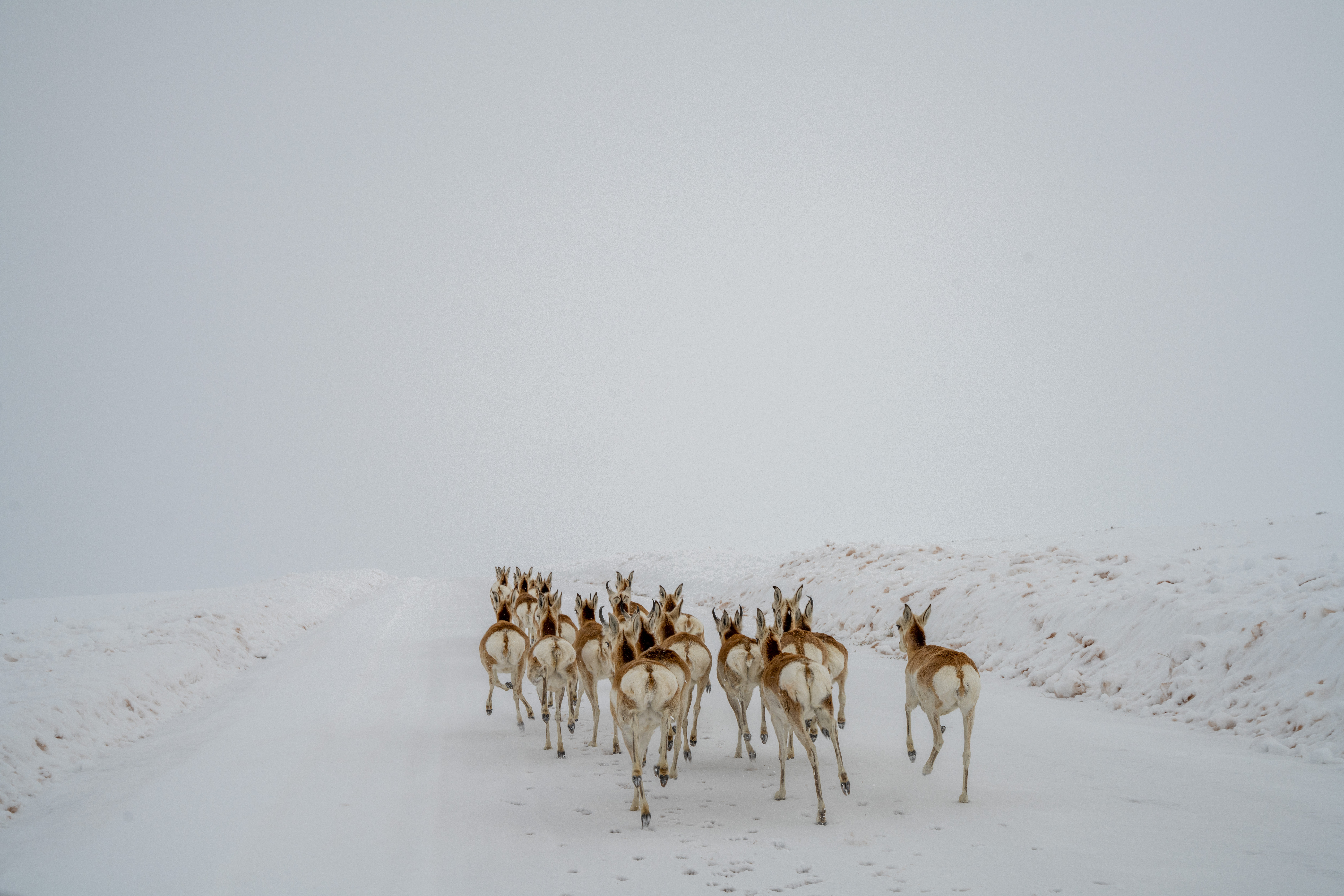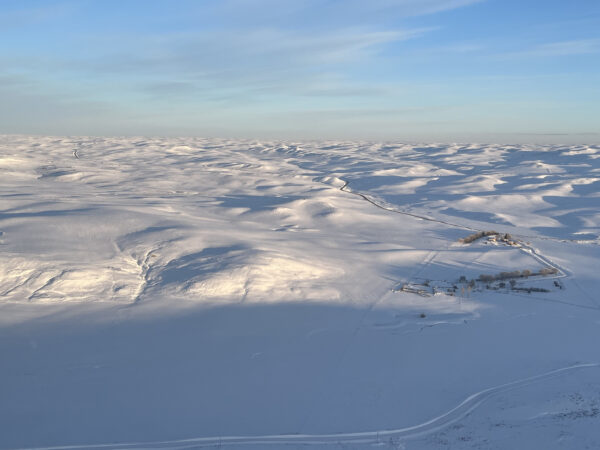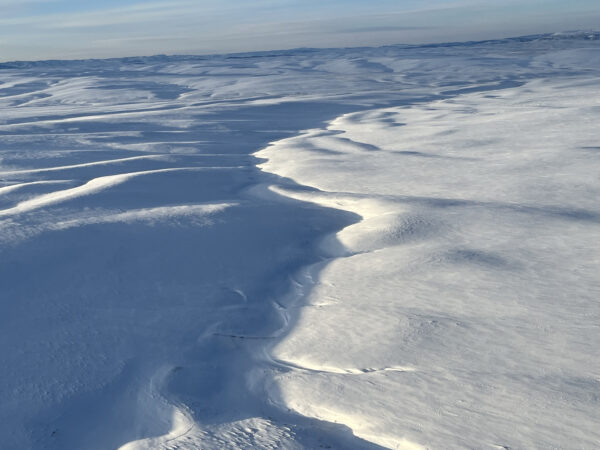
Winter in the Northwest: Surviving today and after the snow melts
By Rachael Gonzales
It has been a tough winter for wildlife in the northwest corner of Colorado. Since the start of the season, the National Weather Service’s Maybell weather station has recorded over 80 inches of snow in the area. Prolonged snow combined with strong gusty winds has made an already hard time of year for wildlife even more difficult. Food has been extremely difficult for the big game to find as much of it is covered by deep, hard-packed snow. This has forced thousands of animals to migrate farther west than they typically do, burning much-needed fat and calories they likely won’t replenish.
“It’s tough,” said Assistant Area Wildlife Manager Mike Swaro. “There’s no other way to describe it. We typically see some mortality from starvation every winter. That’s just nature. Not every animal survives. This year it feels like all we’re seeing is starving or dying animals.”
On a recent trip to Craig, Colorado, to document winter conditions and the hard work being done by local staff to reduce elk and livestock conflict, Northwest Region Public Information Officer Rachael Gonzales rode with District Wildlife Manager Jeffrey Goncalves, whose area had been hit with back-to-back blizzards. While looking at a bait site west of Maybell, the two noticed a mature bull elk that was unable to get up after several attempts. After watching and evaluating the elk for several minutes, the decision was made to euthanize the bull so it would no longer suffer from starvation.
“It’s tough to see any animal suffer,” said Goncalves. “I care for Colorado’s wildlife, it’s why I entered the wildlife conservation field. My worst days are the days when I have to make the decision to end an animal’s life just to end its suffering. It gets to you, too. The constant calls for sick animals who can’t get up along the roadways or in yards. Knowing when you arrive that the likelihood of you having to euthanize the animal to end its suffering is high.”
“I don’t envy our district wildlife managers who have to make these decisions,” said Rachael Gonzales. “Sometimes they have to make the tough call and euthanize an animal. I know they do it only when there’s no other choice.”
In addition to mortality from malnutrition, wildlife officials have seen an increase in animals injured or killed in vehicle collisions. With normal migration routes difficult for wildlife to navigate, they have resorted to using roadways as they search for food. Sometimes that food is located on a narrow shoulder along a windy section of road. Wildlife officials are also seeing animals bed down on roadways after a sunny day to get a little warmth and reprieve from the cold.
In January, distinct wildlife managers responded to two separate incidents involving pronghorn-vehicle collisions. On January 14, a semi going eastbound from Utah on Highway 40 hit 35 pronghorn on the road near Dinosaur. A few days later, on January 19, another group of 18 pronghorn was hit by a pickup truck on a county road near Craig. In all, local district wildlife managers have responded to four incidents involving vehicle collisions with groups of ten or more pronghorn.
While significant, these conditions aren’t new to the area. The combination of persistent summer drought conditions and above-average snowfall during the winter in recent years has resulted in poor range conditions for wildlife. The silver lining is that this winter has not had nearly the number of sub- to below-zero weeks. With a snowpack 143% above average, natural springs that have run dry in recent years will more than likely have water once again.
What’s next: After the snow melts
Although spring is officially here, winter conditions still continue to hold on. While local staff has started to see some improvements, there’s still significant amounts of snow on the ground. What happens when the snow finally melts and the green-up begins? The simple answer is we don’t know. While local wildlife managers and biologists hope to see large numbers of elk and deer migrate back to their summer home range as we have seen in the past, thanks to collar data, we have no way of knowing how many have survived to make the journey back. Those that do make the journey are likely to see some improvement to drought conditions those areas have experienced over the past ten years thanks to all the recent moisture.
Each year in March, wildlife officials set big game license numbers. This is done using herd management plans, hunter harvest data from the previous year, and classification flights done in the late fall and winter. This winter has been hard for big game in the Bears Ears and White River deer and elk herds and exceptionally hard for the Great Divide pronghorn herds.
In an area known for some of the largest elk herds in the nation, severe winter conditions have resulted in high elk calf mortality and above-average cow mortality. For deer, the combination of severe winter conditions and the high prevalence of Chronic Wasting Disease has affected the resiliency of this population. Over the past several years, biologists have observed a decrease in population, and the sex ratio has fallen below the objective set in the Deer Herd Management Plan.
Pronghorn are seeing significant impacts this winter and have migrated in large numbers out of the Great Divide Data Analysis Area (DAU) into the Sandwash Basin. Significant mortality is being observed from aerial and on-the-ground observations. With extreme winter conditions persisting through March, pronghorn mortality continues to increase. Poor winter habitat conditions, little to no food sources, and increased vehicle-wildlife collisions have led to higher-than-normal mortality rates.
CPW biologists wish they could predict what will happen during the spring green-up and summer months; however, there is no way to know if the pronghorn that survived this winter will migrate back to the Great Divide DAU. For many, migrating back to their home range means traveling 70 or more miles already exhausted and on very little fat reserves left after a harsh winter. Choosing to migrate back to the east or stay has become one of life or death for many animals.
“I wish we could see into the future,” said Area Terrestrial Biologist Darby Finley. “Unfortunately, we don’t know what Mother Nature has in store for the next couple of months. However, we are fortunate to have radio collars out on deer in the White River herd and elk in the Bear’s Ears herd and will be able to quantify survival in these herds. Pronghorn herds will be more difficult to assess until the snow melts.”
Using the data collected over the past several months and anticipated additional losses throughout the spring, biologists are taking conservative approaches with this year’s license recommendations. They are recommending significant reductions in the number of licenses for elk and deer in the Bears Ears and White River DAUs, and pronghorn in the Great Divide DAU for the 2023 big game season.
“This has been a tough year for licenses setting in the Craig area,” said Area Wildlife Manager Bill de Vergie. “We know this impacts more than just CPW. These decisions also have impacts on hunters and the local economy. That’s what makes these decisions the hardest. My hope is they understand this isn’t something we wanted to do. It’s something we had to do.”
Colorado Parks and Wildlife understands many hunters, residents, and non-residents come to this area every year to hunt big game. Some generations have traveled to this area in the northeast corner to harvest needed protein for their family’s survival. With recommendations to make significant reductions in licenses, in most cases a reduction over 40%, the Northwest Region staff hope providing this information ahead of time will give hunters an opportunity to change their hunt plans and explore new areas across our beautiful state.
It is important to note, at this time, these reductions are recommendations. These recommendations will be presented at the Parks and Wildlife Commission meeting in May for final approval by Parks and Wildlife Commissioners.
Funding
Colorado Parks and Wildlife relies primarily on license sales, state park fees, and registration fees to support its operations and mission. For fiscal year 2021-2022, 69% of wildlife funding came from the purchase of licenses and passes. These include fishing licenses, big and small game licenses, waterfowl hunting licenses and habitat stamps; license application and preference point fees; and State Wildlife Area (SWA) use permits, access permits, and special use permits.
Learn more about CPW’s funding sources and uses of funds in the Sources & Use of Funds fact sheet.

Deer gather at a bait site near Maybell, Colo.


Aerial photos of winter conditions.
Support Northern Colorado Journalism
Show your support for North Forty News by helping us produce more content. It's a kind and simple gesture that will help us continue to bring more content to you.
BONUS - Donors get a link in their receipt to sign up for our once-per-week instant text messaging alert. Get your e-copy of North Forty News the moment it is released!
Click to Donate
